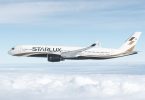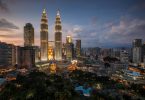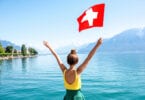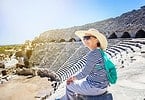LISBON, Portugal (eTN) – Every now and again a new form of high-speed transit appears such as the TGV, wide-body airliner, Concorde and so on, but nothing quite compares with the supersonic marvel that forms the basis of Richard Branson’s futuristic space tourism operation called Virgin Galactic.
SpaceShipTwo is the rather colorless name of the suborbital dream machine he has designed and built to carry space tourists above the 100-km Kármán line, and hopefully back again.
Porto-born entrepreneur Mário Ferreira has already booked his ticket and is raring to go, but doesn’t the idea of boldly going where fewer than five hundred people have been before worry him at all?
“I know the spaceship will be rigorously tested before departure and I fully believe in the technology, otherwise I wouldn’t be going,” he affirms.
And going he is, sometime between autumn 2009 and spring 2010 if Branson gets the green light, guaranteeing him the trip of a lifetime for a cool US$200,000, travel insurance not included.
Many happy returns
As one of the “founders,” a name attributed to the first 100 Virgin Galactic passengers, Ferreira is keen to be making his contribution today so that the common man will be able to fly into space and back tomorrow.
“We’re guinea pigs in a sense, part of a huge experiment to secure the future of space tourism throughout the world.”
Like space itself, there are no boundaries and the possibilities on the other side of the earth’s atmosphere are infinite, a notion that prompts him to predict that orbital resorts will be a common feature in ten years’ time, while in just twenty years he’s even confident there’ll be a space tourism resort on the moon.
“It’s no longer science fiction. Before my 60th birthday, I’m planning to spend my holidays on the moon. And once we have the first settlement there, it will be equally possible to send people to Mars and beyond,” he declares.
Rocket man
For the time-being though, he will be focusing on this next small step for man on SpaceShipTwo, a trip that will take around two and a half hours from take off to touch down in the US, accompanied by five other passengers and two pilots.
Weightlessness will only last a few minutes, giving Ferreira the chance to release himself from his seat and float around the cabin.
“I’m really looking forward to floating and relaxing and doing all those crazy things people do in space. I want to do a bit of everything and at the same time take lots of photographs with which to remember the whole amazing experience,” he says.
The spacecraft will go beyond the defined boundary of space and reach a height of 110 km, attaining a speed of Mach 3 (1000 m/s) in the process, slightly faster than today’s fighter jets.
It will then fold its wings to re-enter the atmosphere before returning them to their original position for the final descent. Once safely back on earth, Portugal’s first-ever space traveler plans to publish a book of his adventure featuring many of the photographs he took during the flight.
Pass the Port
Space travel, as we all know, needs plenty of planning and Ferreira has thrown himself into an exhaustive training program in order to prepare for the rigors that lie ahead.
“I’ve been doing additional zero-gravity training so that I’ll know exactly how to act during those vital minutes of weightlessness,” he explains.
“All the training is done in the United States and the last session I did was in the G-force centrifuge in Philadelphia, which wasn’t particularly pleasant!”
Prior to take-off, there will be three days of pre-flight preparation, bonding and training on-site at the spaceport.
And as with any journey, whether it’s a weekend in Wales or a suborbital space voyage, the problem of what to take is always a major preoccupation.
“I’ll be taking my camera – a top-of-the-range Nikon – plus lots of spare batteries and memory cards and some Port wine,” says Ferreira.
Did he really say Port wine?
“Yes, a half-liter bottle of Taylor’s, probably the 2004 vintage, in a special PVC container. The idea is to see if it loses any quality during its time in zero gravity and, on my return, some of the world’s top wine experts will blind-taste it to check.”
Cheers! Anyone taking the Stilton?
Star quality
From his home-base in Porto, Mário Ferreira has built up a multi-million-euro business portfolio that is now heading for the stars.
His new space tourism enterprise, Caminho das Estrelas (Voyage to the Stars), has similarities with his ambition to develop the Douro for leisure purposes fifteen years ago, a plan considered by many at the time to be problematic and doomed to failure.
The Douro Azul cruise operation subsequently flourished and became one of Portuguese tourism’s great success stories. He now hopes that the Caminho das Estrelas venture will follow a similar path and eclipse all his previous achievements.
“Space tourism is a very exciting prospect and presents more than one pillar of business. We have an exclusive license to sell Virgin Galactic in all Portuguese-speaking countries, including Brazil. We’re also the local representatives for visits to the Kennedy Space Centre, zero-gravity flights and holidays at the orbital resorts of the future. Another part of the business includes the sale of space toys in Portugal and Spain,” he explains.






















